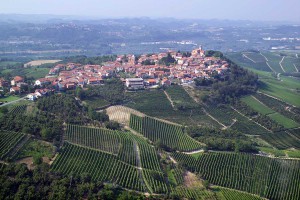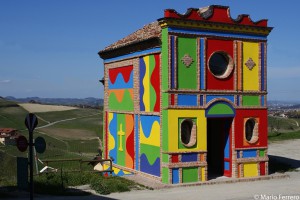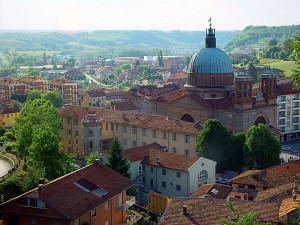Wandering through Langhe in discovery of noble residences
The tour starts at Verduno, defined as the “Sentinel of Langhe”. In fact, the viewpoint from the top of the village is one of the most spectacular, panoramic and romantic spots overloking the most gentle Langa, offering visitors the charm of a resting and silent place.
From the evocative Piazza Castello, the plaza situated just outside the castle, it is possible to admire the castle designed by Filippo Juvarra around the middle of the 18th century. In 1838, it was bought by King Charles Albert who transformed it into one of the most refined residences of the Savoy family, with a focus on the wine producing aspect. Here, thanks to the help of the oenologist of the Savoy House, General Staglieno, one of the first bottles of Barolo in history was created. And it is right in the area of this enchanting village that the unique and extremely particular vine variety called Pelaverga has found its natural habitat. Thanks to this variety it is possible to produce the now famous ‘Verduno Pelaverga’.
From Verduno we go up towards La Morra, one of the main areas for Barolo production. In the village, via Umberto, the ancient main road where all the shops once were, goes up steeply towards the centre and reaches the Castle square. Here is the “Belvedere”: a great balcony overlooking the Langhe and the Alps which offers a unique and breathtaking view. Half of Piedmont stretches out in front of the visitor, and forms a never ending line of hills dotted with hamlets, castles, and towers stood surrounded by vineyards. A stop that cannot be left out is the little hamlet of Annunziata, three kilometres from La Morra, along the country road for Alba. Here it is possible to visit the Romanesque-baroque complex of the former Benedectine convent of San Martino di Marcenasco, an Abbey representing the most ancient heart of La Morra. Inside, the monks used to grow Nebbiolo, Moscatello and Pignolo grapes. In the cellars you will find the Museum Ratti dei Vini d’Alba where ancient tools, historical documents, ampelographic tables and vineyard maps tell the story of the wine and vine varieties of this area. In Brunate, near one of the most prestigious vineyards of La Morra, is a colourful little chapel dedicated to Our Lady of Graces.
A stop that cannot be left out is the little hamlet of Annunziata, three kilometres from La Morra, along the country road for Alba. Here it is possible to visit the Romanesque-baroque complex of the former Benedectine convent of San Martino di Marcenasco, an Abbey representing the most ancient heart of La Morra. Inside, the monks used to grow Nebbiolo, Moscatello and Pignolo grapes. In the cellars you will find the Museum Ratti dei Vini d’Alba where ancient tools, historical documents, ampelographic tables and vineyard maps tell the story of the wine and vine varieties of this area. In Brunate, near one of the most prestigious vineyards of La Morra, is a colourful little chapel dedicated to Our Lady of Graces.  Built in 1914 by a rich farmer to provide a shelter for people working in the surrounding vineyards in case of heavy storm or hail, the chapel was neither sanctified nor the destination of pilgrimage believers. With the years, since it was no more used and almost abandoned, it became rundown. When in 1976, the Ceretto brothers, owners of the wine growing and making company of the same name, bought some hectares of vineyards in that area, they met the English artist David Tremlett and together they decided to restore it. Tremlett adorned the inner part, while the American artist Sol Lewitt, a friend of his, worked on the outside. Artisans, local artists and other people completed the spectacular work. From La Morra, take the country road in the direction of Barolo – Novello, which will offer you an amazing view of the hills of Bassa Langa, vineyards, and the castles of Serralunga and Grinzane. In the little hamlet of Vergne, it is possible to explore a special itinerary to discover some murals depicting aspects of rural life, realized by various painters of Langa. Before Castello della Volta, you will notice, on the left, the rural chapel of San Pietro de Vignoleis, which can be translated as “Saint Peter of the Vineyards” and local people call San Pietro delle Viole, “Saint Peter of the Violets”. Here, a picnic area provides a nice stop-off point to rest and admire the enchanting view on the Barolo vineyards below. The street to Novello passes under the walls of Castello della Volta, a majestic manor, today almost abandoned. Probably built around the 12th-13th century, it was then bought by the Falletti family who used it as their usual residence. But soon it started to have quite an unusual reputation since it was the set of raging orgies and late night feasts. Still today, the legends say that on nights with a full moon, the halls of the castles become the meeting place of masche, a term that in the Piedmontese tradition identifies witches, and the shadows of ladies and horsemen. It is possible to find the ancient glory of the manor in the decorations on the gothic windows and the cylindrical tower which dominates the complex. After a short journey, it is possible to reach Novello, a nice village with few houses perched on the hill. The village entrance is characterized by the ancient door of the Medieval tower, which is now the bell tower of the parish church dedicated to Saint Michael Archangel (1761 – 1783) probably built as a project of the architect Francesco Gallo from Mondovì.
Built in 1914 by a rich farmer to provide a shelter for people working in the surrounding vineyards in case of heavy storm or hail, the chapel was neither sanctified nor the destination of pilgrimage believers. With the years, since it was no more used and almost abandoned, it became rundown. When in 1976, the Ceretto brothers, owners of the wine growing and making company of the same name, bought some hectares of vineyards in that area, they met the English artist David Tremlett and together they decided to restore it. Tremlett adorned the inner part, while the American artist Sol Lewitt, a friend of his, worked on the outside. Artisans, local artists and other people completed the spectacular work. From La Morra, take the country road in the direction of Barolo – Novello, which will offer you an amazing view of the hills of Bassa Langa, vineyards, and the castles of Serralunga and Grinzane. In the little hamlet of Vergne, it is possible to explore a special itinerary to discover some murals depicting aspects of rural life, realized by various painters of Langa. Before Castello della Volta, you will notice, on the left, the rural chapel of San Pietro de Vignoleis, which can be translated as “Saint Peter of the Vineyards” and local people call San Pietro delle Viole, “Saint Peter of the Violets”. Here, a picnic area provides a nice stop-off point to rest and admire the enchanting view on the Barolo vineyards below. The street to Novello passes under the walls of Castello della Volta, a majestic manor, today almost abandoned. Probably built around the 12th-13th century, it was then bought by the Falletti family who used it as their usual residence. But soon it started to have quite an unusual reputation since it was the set of raging orgies and late night feasts. Still today, the legends say that on nights with a full moon, the halls of the castles become the meeting place of masche, a term that in the Piedmontese tradition identifies witches, and the shadows of ladies and horsemen. It is possible to find the ancient glory of the manor in the decorations on the gothic windows and the cylindrical tower which dominates the complex. After a short journey, it is possible to reach Novello, a nice village with few houses perched on the hill. The village entrance is characterized by the ancient door of the Medieval tower, which is now the bell tower of the parish church dedicated to Saint Michael Archangel (1761 – 1783) probably built as a project of the architect Francesco Gallo from Mondovì.
On the opposite side of the village, in a dominant position, there is a castle whose original Medieval structure has unfortunately been totally destroyed. From Novello we descend in the direction of Monchiero, a village once built on a hill that gave it its name, Mons Clarus, and that now stretches across the wide valley floor. Around the year 1000AD, the first families settled here where there was also a castle used as a shelter during the Barbarian incursions. But it didn’t last long because already in 1275 it was so ruined that it had to be demolished; it would have had never been rebuilt. Surely it is worth a stroll in the hamlet of Monchiero Alto, which will enchant you with its charm, its particular atmosphere and the lovely landscape. Of the ancient village, it is still possible to admire and visit the sanctuary dedicated to Our Lady of the Rosary, and a majestic building with a beautiful outer loggia which catches the visitor’s attention when driving on the street towards Dogliani. In the village, on the valley bottom, it is possible to find the house of the painter Eso Peluzzi, who lived and worked here and where you can find a permanent exhibition of his art. From Monchiero take the street on the valley floor to reach Dogliani, the final stop of our tour. The hills in the background, embellished with thousands of geometries of the vineyards and cultivated lands, allow us to soak up all the magic of this land and its best production: the Dolcetto wine from Dogliani. The city is divided into two parts: one in a higher position called Castello, the castle, and the other in a lower position called Borgo, the village. In both districts, amazing for their architecture, you can find parish churches. Still nowadays the Medieval heart can be easily spotted. Dogliani, in fact, is enclosed by the entrance doors of the city, dating back to the 14th century, Porta Soprana and Porta Sottana. Dogliani Castello still retains a ‘ricetto’ set up, a particular fortified area to protect the village, with the covered passage of Porta Gabetti, and the defensive tower of the palace of the family Perno di Caldera (the ancient castle). Right near the medieval fortified tower, in Italian Torrione, and the Municipal Clock Tower, there is a panoramic viewpoint where one can admire the amazing panorama. The Public Library is certainly worth a visit. It was built as a gift of the Einaudi family and dedicated to the most famous citizen the President Luigi Einaudi who was born here. Located along the river, it is in a building designed by the architect Bruno Zevi. One cannot miss Bottega del Vino, a consortium created to promote the Dolcetto from Dogliani, located in the enchanting cellars of a former Monastery of Carmelites with the tiled sandstone vaults dating back to the 16th century.
Still nowadays the Medieval heart can be easily spotted. Dogliani, in fact, is enclosed by the entrance doors of the city, dating back to the 14th century, Porta Soprana and Porta Sottana. Dogliani Castello still retains a ‘ricetto’ set up, a particular fortified area to protect the village, with the covered passage of Porta Gabetti, and the defensive tower of the palace of the family Perno di Caldera (the ancient castle). Right near the medieval fortified tower, in Italian Torrione, and the Municipal Clock Tower, there is a panoramic viewpoint where one can admire the amazing panorama. The Public Library is certainly worth a visit. It was built as a gift of the Einaudi family and dedicated to the most famous citizen the President Luigi Einaudi who was born here. Located along the river, it is in a building designed by the architect Bruno Zevi. One cannot miss Bottega del Vino, a consortium created to promote the Dolcetto from Dogliani, located in the enchanting cellars of a former Monastery of Carmelites with the tiled sandstone vaults dating back to the 16th century.
Wine Cellars Along the Itinerary
Casa Baricalino
, Località Baricalino 7, Novello CNMauro Molino
, Frazione Annunziata Gancia 111A, La Morra CNCrissante Alessandria
, Borgata Roggeri, 44, La Morra CNDosio Vigneti
, Regione Serradenari 6, La Morra CNDiego Morra
, Cascina Mosca 37, Verduno CNBottega del Vino Dogliani
, P.zza San Paolo, 9, Dogliani CNRocche Costamagna
, Via Vittorio Emanuele, 8, La Morra CNCastello di Verduno
, Via Umberto I, 9, Verduno CNMarziano Abbona
, Borgata San Luigi 40, Dogliani CNLe Strette
, Via Le Strette, 1/F int.1, Novello CNCiabot Berton
, Frazione Santa Maria 1, La Morra CNBel Colle
, Fraz. Castagni, 56, Verduno (CN)Moscone
, Regione Cerreto 2, La Morra CNAlessandria Fratelli
, Via Beato Valfré 59, Verduno CNMauro Marengo
, Località San Grato 1, Novello CNAgricola Gian Piero Marrone
, Frazione Annunziata 13, La Morra CNI Brè
, Borgata Breri, 39, Verduno CNNegretti
, Frazione Santa Maria, 53, Località Peso, La Morra CNEnzo Boglietti
, Via Fontane 18/A, La Morra CNPoderi Luigi Einaudi
, Borgata Gombe, 31, Dogliani CNStra Viticoltori with guesthouse
, Località Ciocchini, 5, Novello CNAurelio Settimo
, Frazione Annunziata, 30, La Morra CNTenuta L’Illuminata
, Località Sant'Anna 30, La Morra CNBosco Pierangelo
, Borgata Boiolo, 1, La Morra CNPlaces to Eat Along the Itinerary
Castello di Verduno
, Via Umberto I, 9, Verduno CNAgricola Gian Piero Marrone
, Frazione Annunziata 13, La Morra CNAccommodation Along the Itinerary
Casa Baricalino
, Località Baricalino 7, Novello CNCrissante Alessandria
, Borgata Roggeri, 44, La Morra CNDosio Vigneti
, Regione Serradenari 6, La Morra CNRocche Costamagna
, Via Vittorio Emanuele, 8, La Morra CNCastello di Verduno
, Via Umberto I, 9, Verduno CNAlessandria Fratelli
, Via Beato Valfré 59, Verduno CNPoderi Luigi Einaudi
, Borgata Gombe, 31, Dogliani CNStra Viticoltori with guesthouse
, Località Ciocchini, 5, Novello CNTenuta L’Illuminata
, Località Sant'Anna 30, La Morra CNPlaces to buy Food and Wine Products Along the Itinerary
Paolo Bove – Food and cosmetics based on snail slime of the highest quality
, Loc. Bricco Neri 5, Novello CN




